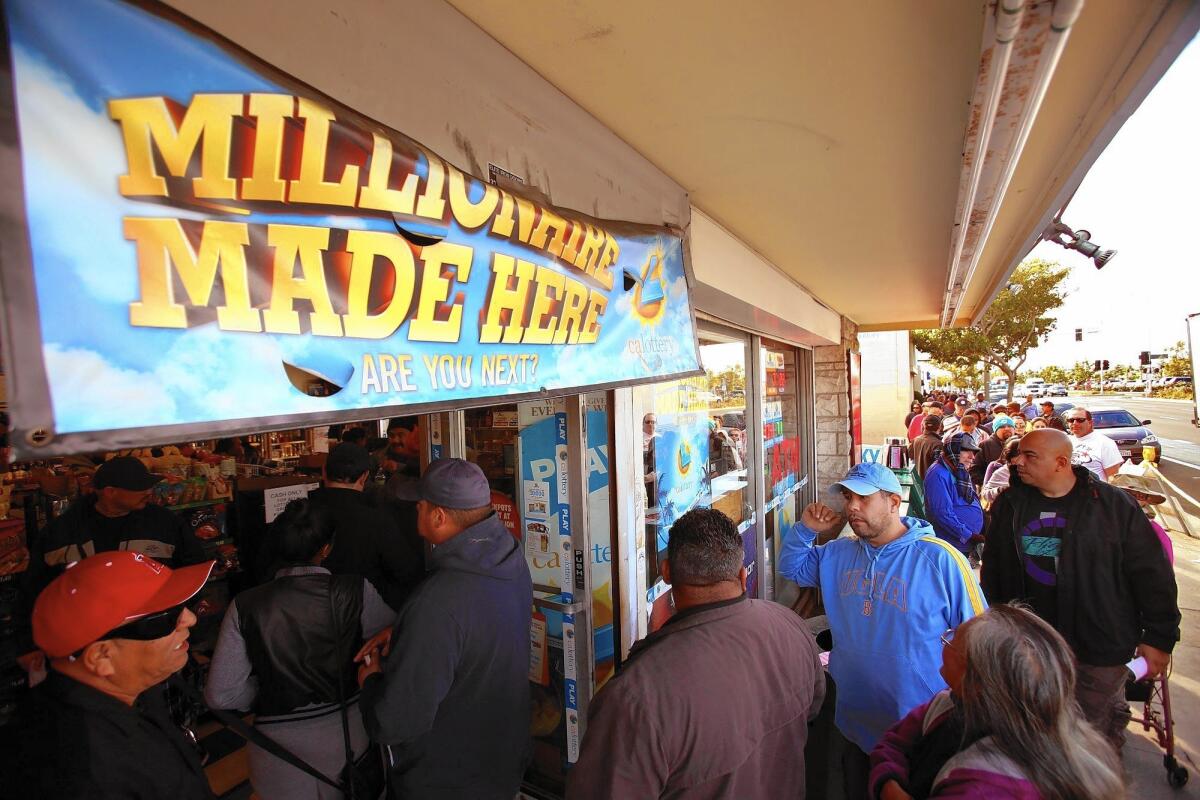The problem with your lottery tickets and school funding
- Share via
Lottery commercials and billboards plastered around the state suggest that the long-shot gamble of buying a lottery ticket can not only make you rich but also make you a better person.
Billboards and videos on the California Lottery’s website make playing the lottery seem like something of a civic duty.
“Thanks for helping us support public schools,” reads one ad from the state lottery’s 30th-anniversary campaign.
A recent analysis by an education nonprofit, however, suggests that what’s really happening is “a $449 million wealth transfer between ‘winners’ and ‘losers’” that can make rich schools richer without doing much to help poor schools.
EdBuild, an organization that focuses on ways to pay for public education, says the state’s distribution of lottery money is unfair.
In fiscal year 2013-14, a total of $1.3 billion from the lottery went to California schools. Almost all of that amount, representing 21.7% of total lottery sales, went to the state’s K-12 public schools.
Districts statewide got about $163 for every student, as determined by average daily attendance — regardless of how much money is made from lottery ticket sales in those districts.
That distribution, said Rebecca Sibilia, EdBuild’s chief executive and founder, runs counter to California’s recent efforts to address inequity in the way it pays for public education.
As it is, there are essentially two ways the state pays. Regular funding is distributed equally to all schools, while a second stream of money that might be termed “inequity funding” is passed out in a more targeted way, to address the bigger problems in schools with lots of students from low-income families.
California’s new Local Control Funding Formula assumes that some students need more money than others. This attempt at an egalitarian approach, pushed through by Gov. Jerry Brown in 2013, tries to put more taxpayer money into low-income areas where struggling schools’ and students’ needs are greater.
The problem, according to EdBuild’s analysis, is that relatively few rich people buy lottery tickets — but if their children attend public schools, each gets as much money from lottery sales as kids in the state’s poorest school districts.
A fairer distribution would give the money to school districts based on how much the lottery made in those communities, Sibilia said.
Take, for example, the lottery payouts of La Cañada Unified School District, which has the highest median income of any school district in Los Angeles County, and Inglewood Unified School District, which has one of the lowest median incomes.
In fiscal year 2013-14, students in the richer district received about $166 a piece and those in the poorer district received about $164, with the variance probably caused by differences in the way money is allocated to charter schools.
According to EdBuild’s data, that means that La Cañada Unified receives about $105 more per student than it would if the money were allocated proportionally to revenue from the area’s lottery ticket sales. Inglewood Unified, meanwhile, receives $211 less per student than it would on an adjusted formula.

The fair approach, according to EdBuild, would ensure that if a district’s census tracts account for 3% of all lottery sales, that district would receive 3% of the total lottery payout.
The researchers concede that just looking at lottery money distribution at the school district level doesn’t tell the whole story. The data show that many districts that have a low median income appear to be getting as much lottery money as they would on an adjusted formula. That’s possibly because different neighborhoods balance each other out in a district such as L.A. Unified, where the city of Bell may have lots of lottery sales while Bel-Air may have relatively few.
One problem with changing the funding structure is that “it’s difficult to make assumptions about who’s playing the lottery,” said California Lottery spokesman Alex Traverso.
Although more tickets might be sold in low-income areas, customers may live elsewhere — including, in the case of tourists, on the other side of the country. But overall the people who buy lottery tickets regularly tend to be lower-income.
Changing the way money is doled out would not be easy. A 1984 ballot measure created the current lottery, so significant changes would probably require another public vote, said Ken Kapphahn, a fiscal and policy analyst for the California Legislative Analyst’s Office.
But the lottery’s relatively minor contribution to California K-12 schools — about 1.6% of the total dollars allocated in 2013-14 fiscal year — may not be enough to rally reformers, experts said.
“I don’t know if we would necessarily get into the issue of how it’s portioned,” said California State PTA President Justine Fischer.
Even the California Lottery’s own spokesman acknowledged that buying a ticket is an inefficient way to get money to schools.
“Most people aren’t buying tickets because they want to support schools,” Traverso said. “ I think if people are motivated to support their schools they’ll just support their schools directly.”
Times staff writer Joe Fox contributed to this report.
EdBuild receives funding from the Broad Foundation. The Times receives support for its Education Matters digital initiative through several donors. The California Community Foundation and United Way of Greater Los Angeles administer grants from the Baxter Family Foundation, the Broad Foundation, the California Endowment and the Wasserman Foundation. Under terms of the grants, the Times retains complete control over editorial content.
MORE IN EDUCATION:
He brokered deals for an empire of California charter schools -- and now faces a felony charge
The country’s second-biggest school district has a new superintendent. But what does she even do?
Magnet schools: How to navigate one of L.A.’s most complex mazes
More to Read
Sign up for Essential California
The most important California stories and recommendations in your inbox every morning.
You may occasionally receive promotional content from the Los Angeles Times.












